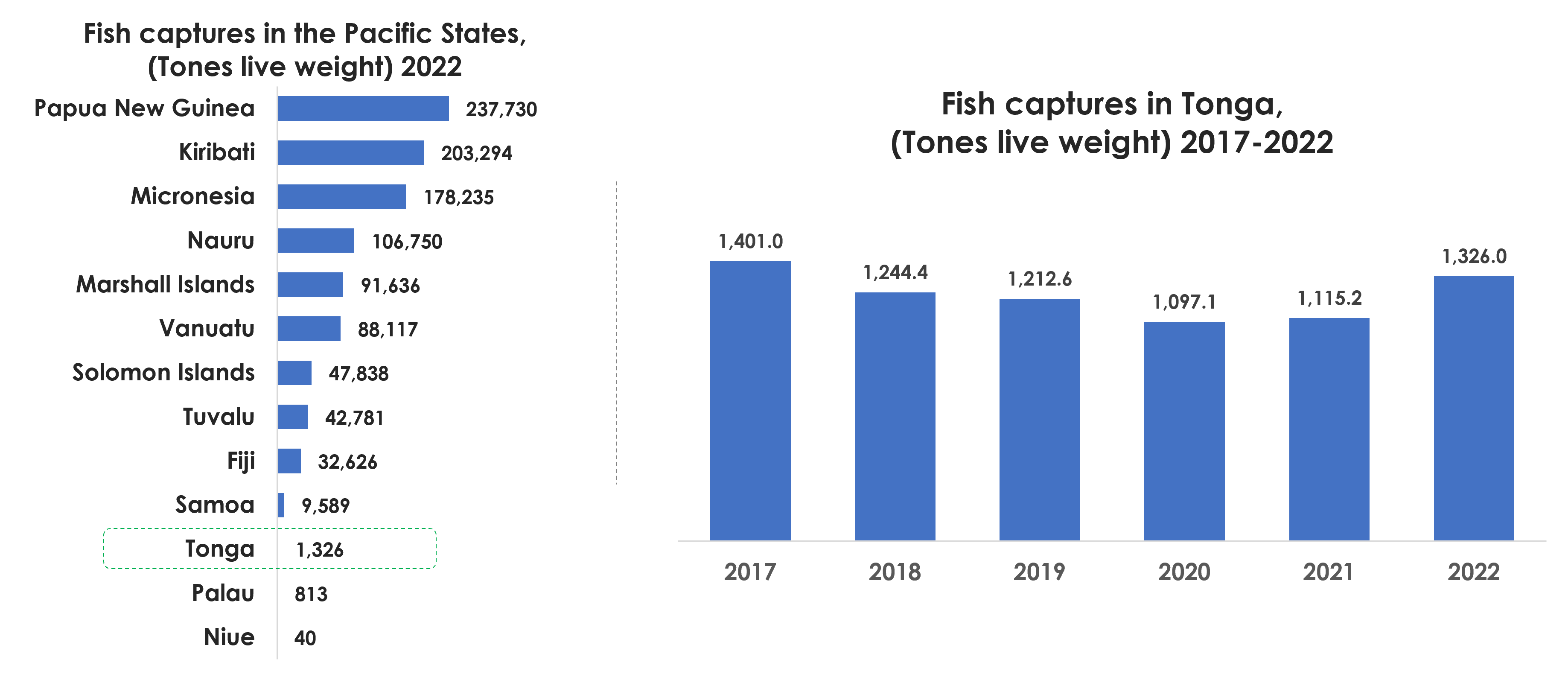Fisheries

- Vital to Tonga’s economy and food security: Fisheries play a key role in Tonga’s economy, culture, and livelihoods. With an Exclusive Economic Zone (EEZ) of nearly 700,000 km²—more than ten times the country’s landmass—Tonga has abundant marine resources and significant untapped investment opportunities in both offshore and coastal fisheries.
- National commitment and strategic planning: The sector is a priority in the Tonga Strategic Development Framework (2015–2025) and the Fisheries Sector Plan (2016–2024), which outlines ambitious targets such as increasing fisheries production by 15%, expanding the national longline tuna fleet, and advancing aquaculture for export markets. These goals are backed by key policy tools such as Tuna Management Plan, Sea Cucumber Development Plan, and investments in processing infrastructure, cold storage, and traceability systems.
- Significant contributor to the economy: Fisheries contribute an estimated 2.9% of Tonga’s GDP, with offshore tuna and deepwater snapper as the leading export commodities. The sector holds further potential for sustainable expansion and value addition.
Potential investment opportunities
- Sustainable commercial fishing: Licensing and partnerships for tuna longline fishing (especially albacore and yellowfin), fleet expansion and modernization.
- Coastal fisheries: Aquaculture farms, hatcheries, and nursery facilities, particularly for seaweed, giant clams, pearls, and shrimp.
- Processing & value addition: Fish processing plants (filleting, freezing, canning), fishmeal and fish oil production.
- Cold chain logistics: Warehouses, refrigerated transport, air cargo expansion, upgraded fish landing sites.
- Seafood certification: MSC & ASC certification services and traceability systems.
- Maritime repair & resupply: Shipyards, dry docks, marine fuel, and resupply stations.

Industry overview
- Modest production with high growth potential: With 1,326 tonnes of fish captured in 2022, Tonga ranks among the lowest producers in the Pacific, highlighting strong headroom for investment, innovation, and value addition across both offshore and coastal fisheries.
- Aquaculture showing promise: An estimated 100 tonnes of aquaculture production were achieved in 2022 led by seaweed farming and supported by ongoing development in giant clam, pearl, and shrimp cultivation.

Source: FaoStat (www.fao.org/fishery/statistics-query/en/capture/capture_quantity - www.fao.org/fishery/statistics-query/en/aquaculture/aquaculture_quantity)
- Fish is a top 5 export: Fisheries products represented 7.1% of Tonga’s total exports from 2021–2023, alongside sectors such as agriculture, postage revenues, and tuber crops.
- Frozen Fish (HS 0303): Dominates Tonga’s fish export revenue, especially in peak years like 2019, when frozen fish accounted for over US$3.7 million. While volumes slightly declined after 2019, frozen fish continues to lead the sector in value, reaching over US$676,000 in 2023.
- Fresh or Chilled Fish (HS 0302): A smaller but consistent share of exports, valued at US$960,000 in 2022 and US$371,000 in 2023.

Source: www.TradeMap.com
- Export destinations for Frozen fish: Over the past five years, the leading destination has been Taiwan, receiving 41.5% of exports, followed by the United States Outlying Islands (18.6%), Vietnam (18.3%). Collectively, these 3 markets account for over 78% of Tonga’s frozen fish trade.
- Export destinations for fresh and chilled fish: United States is the dominant market, accounting for 74% of exports, followed by Japan (11%) and New Zealand (9%). These premium markets highlight Tonga’s capacity to supply high-quality species such as yellowfin and bigeye tuna to discerning buyers.

Source: www.TradeMap.com
